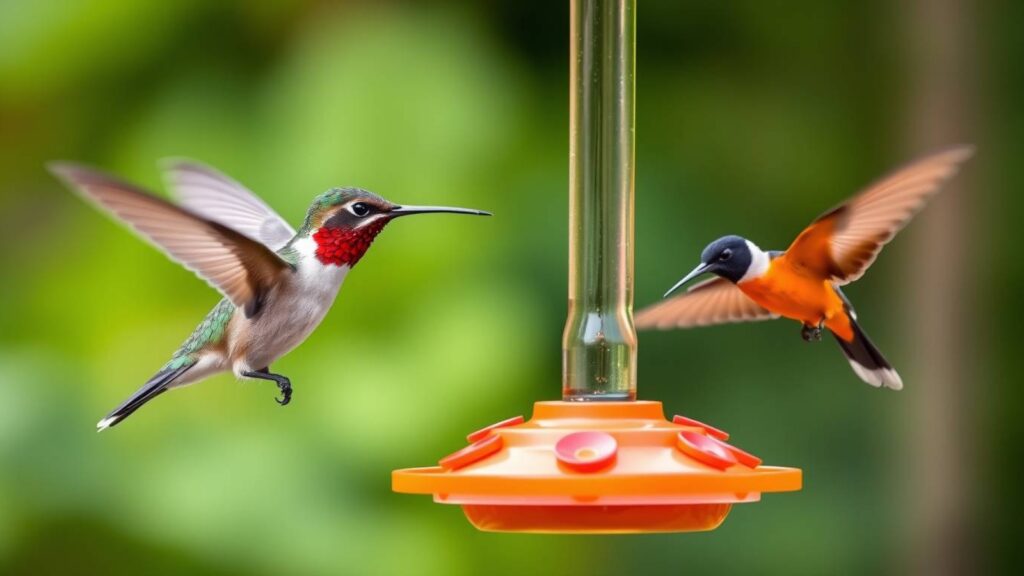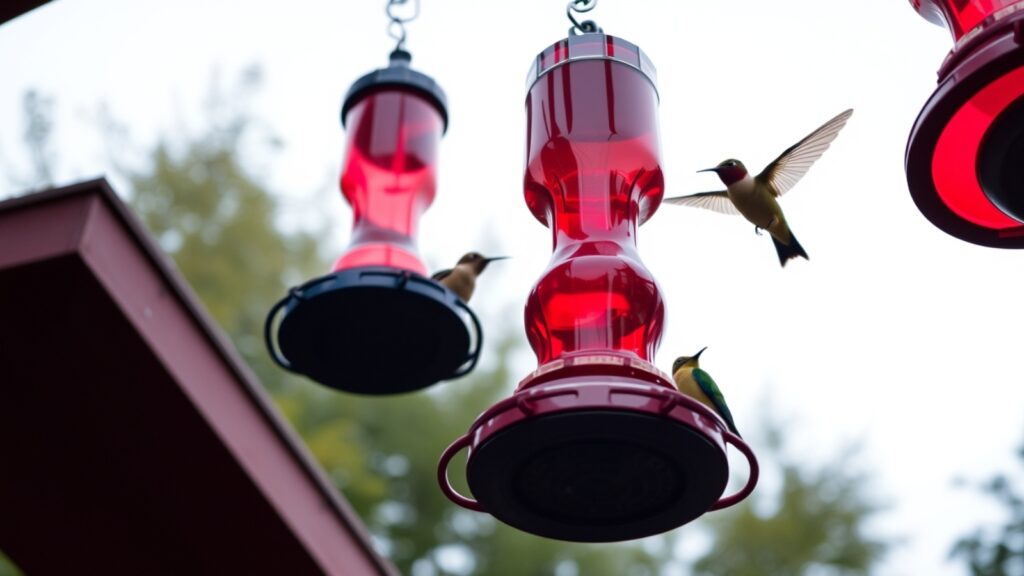Hummingbird and oriole feeders are not the same, though they both dispense nectar. Hummingbird feeders feature small, tubular ports and minimal perches, typically in red colours, while oriole feeders have larger ports, sturdier perches, and often come in orange with extra spots for fruit or jelly.
These differences reflect the unique feeding habits and physical characteristics of each bird species.
In this blog post, we’ll explore the key differences between hummingbird and oriole feeders, helping you choose the right option for your garden visitors.
We’ll also discuss whether these feeders can be used interchangeably and share tips for attracting both species to your garden.
Key Takeaways:
Hummingbird and oriole feeders serve different purposes with distinct designs. While both provide nectar, oriole feeders have larger ports and perches, plus additional features for fruit and jelly. Hummingbird feeders are specifically designed with smaller feeding ports for their thin beaks.
Related post: 15 Best Hummingbird Feeders Compared.
Understanding the Key Differences Between Hummingbird and Oriole Feeders
The main distinctions between these two types of feeders stem from the unique characteristics of the birds they’re designed to attract. Let’s examine these differences in detail:
Physical Design and Appearance
Hummingbird feeders typically feature a compact design with small, precise feeding ports. They’re usually decorated in bright red, as this colour naturally attracts hummingbirds. The ports are designed to mimic tubular flowers, perfectly accommodating the long, thin beaks of hummingbirds.
Oriole feeders, on the other hand, are larger and often orange in colour. They feature wider feeding ports that match the thicker beaks of orioles. Many oriole feeders also include additional features like fruit spikes or jelly cups, catering to these birds’ varied diet preferences.
Feeding Ports and Accessibility
The size and shape of feeding ports represent one of the most significant differences between these feeders. Hummingbird feeder ports are typically 3-4 millimetres in diameter, allowing these tiny birds to insert their needle-like beaks easily. These small openings also help prevent larger birds from accessing the nectar.
Oriole feeder ports are considerably larger, usually 8-10 millimetres in diameter. This wider opening accommodates the orioles’ shorter, thicker beaks and allows them to feed comfortably without struggling to access the nectar.
Perch Design and Support
Another crucial distinction lies in the perch design. Hummingbird feeders often have minimal perching areas or none at all, as these birds can hover while feeding. When present, the perches are small and delicate, matching the tiny size of hummingbirds.
Oriole feeders require sturdy, larger perches to support these bigger birds while they feed. The perches are typically longer and more substantial, allowing orioles to stand comfortably while accessing the nectar, fruit, or jelly.

Can These Feeders Be Used Interchangeably?
While it’s possible for both species to use either type of feeder, it’s not ideal for several reasons:
Hummingbirds might find oriole feeders overwhelming and may feel exposed to predators when using the larger perches. They might also face competition from larger birds, including orioles themselves.
Orioles can struggle with hummingbird feeders due to their larger beaks and body size. The small ports and perches might make feeding difficult or impossible, potentially causing frustration or even damage to the feeder.
Best Practices for Feeding Both Species
To create an optimal feeding environment for both hummingbirds and orioles, consider these recommendations:
Nectar Recipe and Maintenance
Both species can consume the same nectar mixture: one part white sugar to four parts water. However, their feeding habits and preferences differ:
- Clean and refill hummingbird feeders every 3-5 days
- Replace oriole feeder nectar every 2-3 days, as these larger feeders are more exposed to sunlight
- Never use artificial sweeteners, honey, or red dye in either feeder.
Placement and Positioning
To maximize success with both types of feeders:
- Place feeders at different heights and locations
- Keep hummingbird feeders away from oriole feeding stations
- Position feeders near natural shelter like trees or shrubs
- Ensure feeders are visible from multiple angles.
Additional Features and Accessories
Understanding the extra features available for each type of feeder can help you make the most of your bird feeding experience:
Hummingbird Feeder Accessories
The world of hummingbird feeders offers several helpful additions:
- Ant moats to prevent insects from reaching the nectar
- Bee guards that protect the feeding ports
- Perch attachments for better viewing opportunities
- Rain guards to prevent nectar dilution.

Oriole Feeder Special Features
Oriole feeders often come with extra components designed for their varied diet:
- Fruit spike attachments for orange halves
- Built-in jelly cups
- Multiple feeding stations to reduce competition
- Larger rain guards to protect the feeding area.
Seasonal Considerations
Timing plays a crucial role in using these feeders effectively:
Spring and Summer
- Put out oriole feeders in early spring before their migration
- Keep hummingbird feeders filled throughout the summer
- Clean feeders more frequently during hot weather
- Provide fresh fruit for orioles regularly.
Autumn and Winter
- Remove oriole feeders after migration
- In warmer regions, maintain hummingbird feeders for winter residents
- Clean and store feeders properly during off-seasons
- Mark your calendar for next season’s feeding schedule.
Common Problems and Solutions
Every bird enthusiast faces challenges when feeding these species. Here are some common issues and their solutions:
Nectar-Related Issues
- Problem: Nectar fermentation
- Solution: Replace nectar more frequently during hot weather and clean feeders thoroughly
- Problem: Cloudy nectar
- Solution: Use only pure white sugar and clean water; avoid honey or artificial sweeteners.
Pest Management
- Problem: Ants invading feeders
- Solution: Install ant moats or use feeders with built-in ant guards
- Problem: Bees and wasps around feeding ports
- Solution: Choose feeders with bee guards or move feeders slightly if insects become problematic.
Making Your Garden More Attractive
To create an ideal environment for both species:
Plant Selection
Choose flowers and plants that naturally attract these birds:
- For hummingbirds:
- Trumpet honeysuckle
- Cardinal flower
- Bee balm.
- For orioles:
- Native fruit trees
- Trumpet creeper
- Native flowering vines.
Garden Layout
Create a bird-friendly space by:
- Providing different height levels for feeding
- Including water sources like bird baths
- Maintaining natural shelter areas
- Offering multiple feeding stations.
Final Thoughts
Understanding the differences between hummingbird and oriole feeders helps create a more welcoming environment for these beautiful birds. While the feeders share some similarities, their specialized designs reflect the unique needs of each species. By providing appropriate feeders for both hummingbirds and orioles, you can enjoy watching these fascinating birds visit your garden throughout their feeding seasons.
Have you noticed any interesting behaviours when different bird species interact at your feeders? Share your experiences in the comments below!
Frequently Asked Questions (FAQ: Are Hummingbird and Oriole Feeders the Same?)
Q: Can orioles drink from hummingbird feeders?
A: While orioles can technically drink from hummingbird feeders, they often struggle with the small ports and delicate perches. The design isn’t optimal for their larger size and different feeding style.
Q: Do orioles and hummingbirds use the same nectar recipe?
A: Yes, both species can use the same nectar recipe of one part white sugar to four parts water. However, orioles also enjoy additional treats like fruit and jelly, which hummingbirds don’t eat.
Q: How often should I clean these feeders?
A: Clean hummingbird feeders every 3-5 days and oriole feeders every 2-3 days. In hot weather, clean them more frequently to prevent the nectar from spoiling.
Q: Why are oriole feeders usually orange?
A: Oriole feeders are typically orange because orioles are naturally attracted to this colour, just as hummingbirds are attracted to red. This colour preference helps the birds locate their food sources more easily.
Q: Can I use the same feeder for both species?
A: While it’s possible, it’s not recommended. Each species has specific feeding needs and behaviours that are best served by their specially designed feeders. Using separate feeders reduces competition and ensures both species can feed comfortably.
